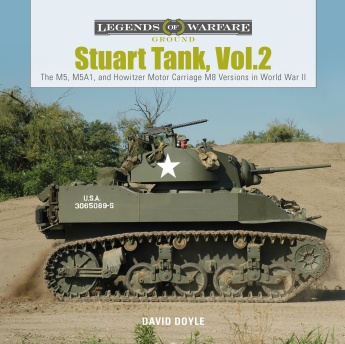|
|
|
|
Stuart Tank, Vol. 2
The M5, M5A1 and M8 Versions in World War II
Reviewed by Peter Brown
Summary
Title: |
The M5, M5A1 and M8 Versions in World War II Legends of Warfare: Ground, 10 by David Doyle Schiffer Books, Atglen, PA USA |
ISBN: |
978-0-7643-5823-4 |
Price: |
US$18.50; GBP18.99 |
Review Type: |
First Read |
Advantages: |
Good source material. |
Disadvantages: |
None noted |
Recommendation: |
Lots of clear photos, informative text |
FirstRead
This book covers the later Stuart series of Light Tanks. The M3 Stuart - as it was known to the British - evolved from a series of Light Tanks developed in the 1930s. It came in several variations, all using the same suspension, engine and drive which were well proven and reliable. Their 37mm guns and armour protection were adequate when first introduced though later outclassed. But demand for their radial engines meant something new was needed.
The solution was to use two car engines coupled with an automatic transmission. These were mated to a new hull with a longer lower part, a raised rear deck and hatches for the driver and co-driver on top. Suspension was unchanged. Light Tank M5 used a turret much the same as the M3A1 so the radio was in the hull. They were replaced by the M5A1 version with the turret from the M3A3 which had a rear bustle for the radio. Both versions used the 37mm main gun with coaxial, antiaircraft and hull .30" calibre machine guns.
To support these tanks the Howitzer Motor Carriage M8 had an open-top turret with a short-barrel 75mm howitzer. This was as wide as the hull which meant that the driver and co-driver hatches were placed on the sloping hull front. A .50" machine gun was fitted to the back of the turret for use against aircraft.
M5's were first used in North Africa from late 1942 and were only used by the US. M5A1 were first used alongside them later replaced them with some being passed to Lend-Lease as were a small number of M8. By the war's end they were being phased out and replaced by the more capable M24 Chaffee.
All the basic versions are described and shown using large, clear period black and white photos showing the design changes made during production and also photos of surviving tanks. Over half the book covers use in action with plenty of photos.
As with the earlier book on the M3 series, this a very useful reference source for modellers and anyone interested in WW2 tank design. David Doyle has found an excellent collection of photos and backs them up with details of the series' development in concise, readable text and extensive captions.
Peter Brown for Brett Green, 18 April 2024

